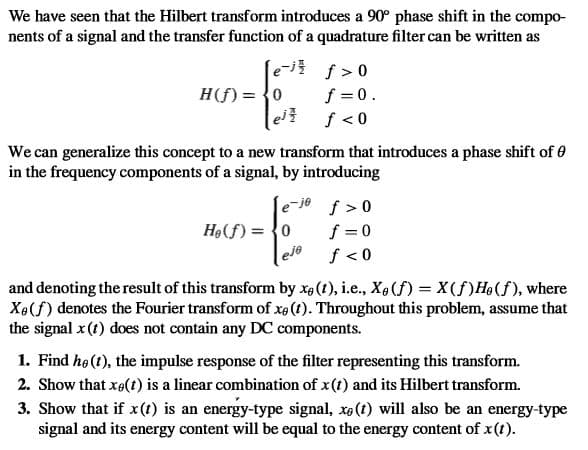We have seen that the Hilbert transform introduces a 90° phase shift in the compo- nents of a signal and the transfer function of a quadrature filter can be written as e H(f) = {0 f >0 f =0. We can generalize this concept to a new transform that introduces a phase shift of 0 in the frequency components of a signal, by introducing e-je f > 0 f = 0 eje Hạ(f) = {0 f < 0 and denoting the result of this transform by xa(1), i.e., X4(f) = X(f)H9(f), where Xe(f) denotes the Fourier transform of xe (t). Throughout this problem, assume that the signal x (t) does not contain any DC components. 1. Find hø (1), the impulse response of the filter representing this transform. 2. Show that xe(t) is a linear combination of x(t) and its Hilbert transform. 3. Show that if x(t) is an energy-type signal, xe(t) will also be an energy-type signal and its energy content will be equal to the energy content of x(t).
We have seen that the Hilbert transform introduces a 90° phase shift in the compo- nents of a signal and the transfer function of a quadrature filter can be written as e H(f) = {0 f >0 f =0. We can generalize this concept to a new transform that introduces a phase shift of 0 in the frequency components of a signal, by introducing e-je f > 0 f = 0 eje Hạ(f) = {0 f < 0 and denoting the result of this transform by xa(1), i.e., X4(f) = X(f)H9(f), where Xe(f) denotes the Fourier transform of xe (t). Throughout this problem, assume that the signal x (t) does not contain any DC components. 1. Find hø (1), the impulse response of the filter representing this transform. 2. Show that xe(t) is a linear combination of x(t) and its Hilbert transform. 3. Show that if x(t) is an energy-type signal, xe(t) will also be an energy-type signal and its energy content will be equal to the energy content of x(t).
Power System Analysis and Design (MindTap Course List)
6th Edition
ISBN:9781305632134
Author:J. Duncan Glover, Thomas Overbye, Mulukutla S. Sarma
Publisher:J. Duncan Glover, Thomas Overbye, Mulukutla S. Sarma
Chapter6: Power Flows
Section: Chapter Questions
Problem 6.16P
Related questions
Question

Transcribed Image Text:We have seen that the Hilbert transform introduces a 90° phase shift in the compo-
nents of a signal and the transfer function of a quadrature filter can be written as
e
H(f) = {0
f >0
f =0.
We can generalize this concept to a new transform that introduces a phase shift of 0
in the frequency components of a signal, by introducing
e-je f > 0
f = 0
eje
Hạ(f) = {0
f < 0
and denoting the result of this transform by xa(1), i.e., X4(f) = X(f)H9(f), where
Xe(f) denotes the Fourier transform of xe (t). Throughout this problem, assume that
the signal x (t) does not contain any DC components.
1. Find hø (1), the impulse response of the filter representing this transform.
2. Show that xe(t) is a linear combination of x(t) and its Hilbert transform.
3. Show that if x(t) is an energy-type signal, xe(t) will also be an energy-type
signal and its energy content will be equal to the energy content of x(t).
Expert Solution
This question has been solved!
Explore an expertly crafted, step-by-step solution for a thorough understanding of key concepts.
This is a popular solution!
Trending now
This is a popular solution!
Step by step
Solved in 8 steps with 18 images

Recommended textbooks for you

Power System Analysis and Design (MindTap Course …
Electrical Engineering
ISBN:
9781305632134
Author:
J. Duncan Glover, Thomas Overbye, Mulukutla S. Sarma
Publisher:
Cengage Learning

Power System Analysis and Design (MindTap Course …
Electrical Engineering
ISBN:
9781305632134
Author:
J. Duncan Glover, Thomas Overbye, Mulukutla S. Sarma
Publisher:
Cengage Learning